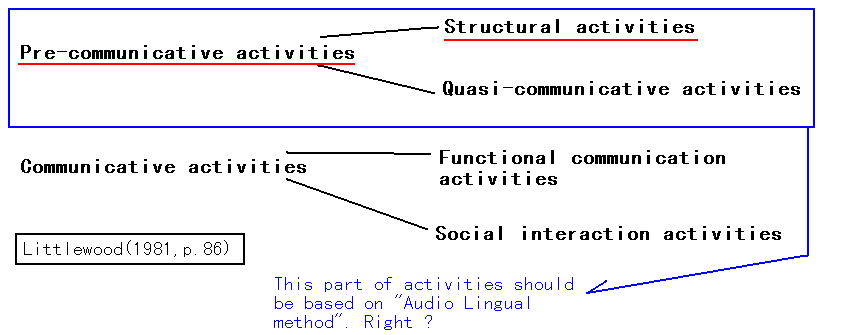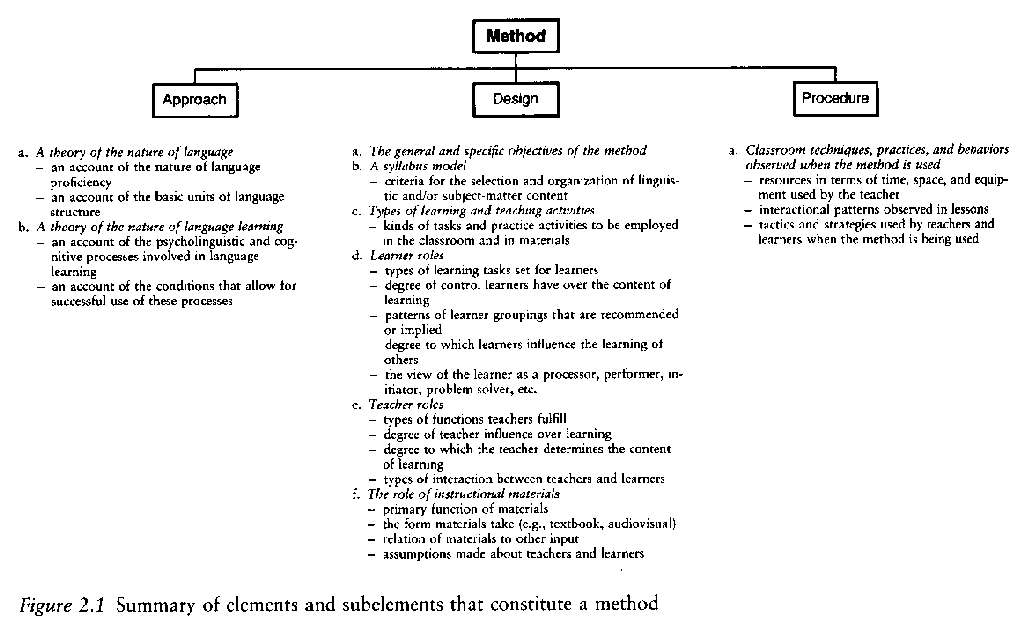
97/02/25 02:17:52
5大教授法
( method levelの下位層にさらに幾重のものapproach, procedureが存在する: CLTなどは時代的にそれ以前のmethodを研究しつくした形になっており理論上はすべてのmethodをカバーしているように見える、しかし、現在その具体的指導の曖昧さ、ハイレベルな要求水準、Syllabusと実生活環境とのギャップ等から見直しが図られる時期に来ている。英語教育法に「これという指導が無い」ということは時代時代で叫ばれてきていることで、"Eclectic Method"が流行る過渡期に至る。今現在がその過渡期で以下の教授法を生徒実態に合わせて使いわけることが望ましいとされる。これは何も英語教育が不安定なのではなく、社会全体が混沌としてきていることからだと私は思っている。日本英語教育史上で特に話題になるCLT と Audio-Lingual Methodを中心に考えていきたい。 )
教授法 |
関連事項 |
|
| Grammar Translation Method | 伝統文法/心理学面皆無/知的訓練/ *the Prussian Method (1845,The ciceronian or the Prussian Method of Teaching the Elements of the Latin Language....by B.Sears | |
| Direct Method | 音声学/幼児言語発達/自然な学習/GDM/ *19c, Gouin,in France & Germany, "the Berlitz Method",small intensive class, O.Jespersen......etc. | |
| Audio-Lingual Method | 構造言語学/行動主義言語学/習慣形成/ * Palmer 1917,Coleman Report in 1929, ASTP, the first English language Institute in 1939 = the University of Michigan(Structural linguistics, C.C.Fries),Pattern practice(mim-mem),The National Defense Education Act(1958), behavioral psychology,inductive,empirically based approach......etc. | |
| Cognitive Approach | 変形文法/言語習得(L.A.D)/認知主義心理学(Bruner)/有意味学習(Ausubel)/ * Noam Chomsky = generalization, transformational syntax, Carrol = cognitive -code, K.Chastain = competence to performance, R.Lakoff.........etc. | |
| Communicative Approach(CLT) | 社会言語学/人間学的心理学/コミュニケーション/
* Applied Linguistics, the Council
of Europe 1971,Notional
Syllabuses(Wilkins 1976),Communicative
competence(Hymes 1972),4 dimensions of communicative
competence( Canale and Swain 1980), Henry Widdowson, Littlewood, ,....etc.
|
n.b.
Coleman Report - - adococate that a more reasonable goal for a foreign language, achieved through the gradual introduction of words and grammatical structures in simple reading texts. The main result of this recommendationwas that became the goal of most foreign language programs in the United reading States(Coleman 1929), The emphasis on reading continued to characterize foreign language teaching in the United States until WWⅡ. Rapid silent reading was the goal.....
ASTP--the entry of the U.S. into WWⅡ had a significant effect on langage teaching in America. To supply the U.S. government with personnel who were fluent in German, French, Italian, Chinese, Japanese, Malay, and other languages, and who could work as interpreters, code-room assistants, and translators, it was necessary to set up a special language training program. The government commissioned personnel. Thus the Army specialized Training Program (ASTP) was established in 1942, 55 American universities were involved in the program by the beggining of 1943. The object of the army programs was for students to attain conversational proficiency in a variety of foreign languages. Since this was not the goal of conventional foreign language courses in the U.S., new approaches were necessary....
The National Defense Education Act--The emergence of the Audiolingual Method resulted from the increased attention given to foreign language teaching in the U.S. toward the end of the 1950s. The need for a radical change and rethinking of foreign language teaching methodology ( most of which was still linked to the Reading Method ) was prompted by the launching of the first Russian satellite in1957. the U.S. Government acknowledged the need for a more intenseve effort to teach foreign languages in order to prevent Americans from becoming isolated from scientific advancces made in other coutries.the National Defense Education Act(1958), among other measures, provided funds for the study and analysis of modern languages, for the development of teaching materials, and for the training of teachers................applicable to conditions in U.S. colleges and university classrooms. They drew on the earlier experience of the army programs and the Aural-Oral or Sructural Appoach developed by Fries and his colleges, adding insights taken from behaviorist psychology...............

Chomsky--"Language is not a habit structure. Ordinary linguistic behavior characteristically involves innovation, formation of new sentences and patterns in accordance with rules of great abstractness and intricacy" (Chomsky 1966;153)
Carroll--"The audio-lingual habit theory which is so prevalent in America foreign language teaching was , perhaps fifteen years ago in step with the state of psychological thinking of that time, but it is no longer abreast of recent developments. It is ripe for major revision, particularly in the direction of joining it with some of the better elements of the cognitive-code learning theory" (Carroll 1966: 105)

The work of the Council of Europe; the writings of Wilkins, Widdowson, Candlin, Christopher Brumfit, Keith Johnson, and other British applied linguists on the theoretical basis for a communicative or functional approach to language teaching; the rapid application of these ideas by textbook writers: and the equally rapid acceptance of these new principles by British language teaching specialists, curriculum development centers, and even governments gave prominence nationally and internationally to what came to be referred to as the Communicative Approach, or simply Communicative Language Teaching.
"He described 2 types of meanings: notional categories ( concepts such as time, sequence, quantity, location, frequency ) and categories of communicative function (requests, denials, offers, complaints)......
時代とともに教授法がいろいろと変遷し、時代のニーズにあわせてその時々の流行り廃りがあるのがはっきりと分かる。 "no single method could gurantee successful results"( a study 1923, USA)であると結論づけたことが過去に何度もあり、そしてまた時代が変遷して新たなる教授法を求めるようになる。
私のような一平教員が考えつくような教授法はそのほとんどがすでに過去において、または現在において研究しつくされている。その結果上記のように時代において廃れている。要するに私は過去における教授法の詳細を知らないだけであったのである。そして国家的規模で研究所が設置され研究された内容は現在に様々に形を変えて残っていることが多い。「外国語の授業なのだから、ターゲット言語で内容が教授されなければならない」などと1時間をfullに英語を使用している指導法はDirect Methodのなごりであり、かつてヨーロッパを中心に全盛した教授法である。そして、それがなぜ廃れてのかを研究すれば現在における改善策も見つかるとは思う。Graded Direct Method などは現在日本で行われている指導法である。教材配列、教員の語学力問題、語彙数制限( comprehensible input )などの問題があるようである。
過去の英語教授法を詳しく文献を見るにつけ、意外なことが判明してくる:
まず、言語の輸出は文化の輸出であり、それは紛れもなく国力の繁栄を意味し、時に政治や、国策が見え隠れしている。過去においてはその傾向が著しく、現在においてもフランス語学習の某学校のようにフランス国からの援助を受けているところもある。いろいろ語弊もあり、おしかりのメール(netnewsの時のように)があるといけないのでこれ以上は述べないが。。。。。。。。。
第二に、日本で広く一般にも知られている教授法関係の文献の多くは、ESL向けである。当たり前であるが、日本はEFLである。しかし、決定的なのはその理論は過去において広く、ヨーロッパから、イギリスから、ロシア(旧ソ)、アメリカからと全世界からのものなのである。そしてそれらの理論は「その国、地域独自の深い事情からどうしても英語力をつけなければならないという急がれた状況(ニーズ)がある」のである。例として、他のページでもあげているが、S.Krashenの"the Natural Approach"は原文で読まれた方も多いと思うが、どう考えてもあの理論を日本の環境に当てはめても当てはまらないことがお分かりいただけるだろうし、彼の理論にも(理論の体系化にはアナがないように詳細にフォローがあるのが普通)、文法指導の必要性が書かれている。良く熟読していくとこの"the Natural Approach"はどうもHyspanic系中心の移民向けのような気がしてくる。1965年の新移民法成立で1970年までの5年間で急増しているのが、南米からの移民であり、アジア圏(特に中国、韓国)からのアメリカへの流入であった(←これについては別紙参照)。移民ともなれば市民権を得るためにもテスティングにパスしなければならないだろうし、ましてや日常使用言語でもある。Hyspanic系はその Group-oriented性が日本人に似ていると良く言われるにしても、環境が違う。更に、私の大のお気に入りである、かのDavid Nunanの"Task-based syllabus" "Collaborative Language Learning and Teaching"も彼の中国系移民に対する教授経験に基づいているらしい(←これは確信ないです、知人の外国人大学教授がそうだと申しております)。
上記のようにESL教授法文献の大半が日本の環境を考慮していない状況で理論立てられているのである。であるから、そっくりそのまま日本の教室に持ち込んでも適応せず、生徒、学習者にはもしかしたら将来的にいい迷惑であるかもしれない。すなわち教授側の供給が学習者側の需要に一致していない状況が生まれてくる。
上記の CLT の Procedure をよく見て欲しい、結局 CLT は過去の教授法の集大成的な面があり、その基礎、基盤となるのはいったい何かと言えば、form や structure なのであり、強いては文法構造、words & phrases なのではないか。Communication能力はあくまで最終ゴールとして定めてありそのゴールに向かって行くアプローチは多岐に渡ってしかるべきだし、道のりも結構遠そうである。私はなぜか、「無理に背伸びしすぎて、生徒学習者側と教師側の需要と供給のバランスがうまくとれていない気がしてならない」。要するに「目標が高すぎて、具体性がなく、生徒が何を学んで良いか分からない」のではないかという懸念が拭い去れない。
仮にコミュニケーション能力が最終目的目標であって、それに向かって段階的指導が成されているのであれば、「文法指導」も否定することは無いと思う。インプットがなくてアウトプットがあるはずがない。「i+1」といってもその"interlanguage"とは人によってまちまちだし、ある生徒にとって"i"であっても別の生徒にとってはまったく"i"になっていない状況がある。これはまさしくTerrellがCalifornia州のSpanishの教師としての授業経験から基づく「少人数制、レベル編成クラス」での仮説授業によるものではなかったかと考えてしまうようなことである。日本の36乃至40人学級では不可能なのではないだろうか。
以上のようにESL関連の教授法は日本の環境に適応していないこと、また、時代毎に社会のニーズによって教授法は変遷すること、そしてそれは常に変わるべきものであることが分かるのではないだろうか。
Reference:

| Never tanslate: demonstrate Never explain: act Never make speech: ask questions Never imitate mistakes: correct Never speak with single words: use sentence Never speak too much: make students speak much Never use the book: use your lesson plan Never jump around: follow your plan Never go too fast: keep the pace of the student Never speak too slowly: speak normally Never speak too quickly: spek naturally Never speak too loudly: speak naturally Never be impatience: take it easy (cited in Titone 1968:100-1) |